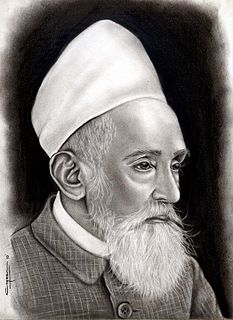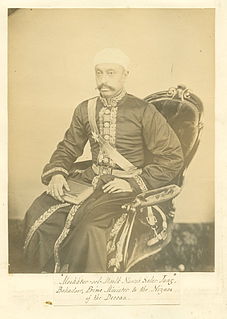Related Research Articles

Hyderabad State, also known as Hyderabad Deccan, was a princely state located in the south-central region of India with its capital at the city of Hyderabad. It is now divided into the state of Telangana, the Hyderabad-Karnataka region of Karnataka, and the Marathwada region of Maharashtra, in present-day India.

The Nizams were the 18th-through-20th-century rulers of Hyderabad. Nizam of Hyderabad was the title of the monarch of the Hyderabad State. Nizam, shortened from Nizam-ul-Mulk, meaning Administrator of the Realm, was the title inherited by Asaf Jah I. He was the viceroy of the Great Mughal in the Deccan, the premier courtier in Mughal India in 1724, and the founding "Nizam of Hyderabad".

Nawab Mirza Khan Daagh Dehlvi was a poet known for his Urdu ghazals. He belonged to the old Delhi school of Urdu poetry.

Asaf Jah VI Sir Mir Mahboob Ali Khan Siddiqi Bayafandi was the 6th Nizam of Hyderabad. He ruled Hyderabad state, one of the Princely states in India between 1869 and 1911.

Mir Osman Ali Khan, Asaf Jah VII, was the last Nizam (ruler) of the Princely State of Hyderabad, the largest princely state in British India. He ascended the throne on 29 August 1911, at the age of 25 and ruled the Kingdom of Hyderabad between 1911 and 1948, until India annexed it. He was styled as His Exalted Highness-(H.E.H.) the Nizam of Hyderabad, and was one of the wealthiest individuals of all time. On 22 February 1937, Time featured him on its cover as the world's richest person, with an inflation adjusted net worth of over $200 billion.

Nawab Arastu Yar Jung (Arabic: نواب أرسطو يار جنك) was a Hyderabadi Surgeon.

The Nizam College is a constituent college of Osmania University established in 1887 during the reign of Mir Mahbub Ali Khan, Asaf Jah VI, in Basheerbagh, Hyderabad, Telangana.

Paigah is a family in the senior aristocracy of Hyderabad State, who were associated with ruling Nizam since its inception. and each maintained his own court, individual palaces, and a standing army of about fourteen thousand troops, both infantry and cavalry.

Mir Nizam Ali Khan Siddiqi, Asaf Jah II was the 2nd Nizam of Hyderabad State in South India between 1762 and 1803. He was born on 7 March 1734 as fourth son to Asaf Jah I and Umda Begum. His official name is Asaf Jah II, Nizam ul-Mulk, Nizam ud-Daula, Nawab Mir Nizam Ali Khan Siddiqi, Fateh Jang, Sipah Salar, Nawab Subedar of the Deccan.

Afzal ad-Dawlah, Asaf Jah VMir Tahniyath Ali Khan Siddiqi was the ruling Nizam of Hyderabad, India, from 1857 to 1869.
Nawab Sir Ahmed Hussain, Amin Jung Bahadur, KCIE, CSI, LLD (Osmania), MA, BL (Madras) was born in Madras on 11 August 1863 in the family of a leading businessman.

Chowmahalla Palace or Chowmahallat is the palace of the Nizams of Hyderabad State in Hyderabad, Telangana, India. It was the seat of the Asaf Jahi dynasty and was the official residence of the Nizams of Hyderabad while they ruled their state. The palace was built by Nizam Salabat Jung. The palace remains the property of Barkat Ali Khan Mukarram Jah, heir of the Nizams. Other members of the Hyderabadi Nizam family have also wed here.

Sir Mir Turab Ali Khan, Salar Jung I,, known simply as Salar Jung I, was an Indian nobleman who served as Prime Minister of Hyderabad State between 1853 until his death in 1883. He also served as regent for the sixth Nizam, Asaf Jah VI between 1869 and 1883.

Nizam Mir Barkat Ali Khan Siddiqi Mukarram Jah, Asaf Jah VIII, less formally known as Mukarram Jah, has been the titular Nizam of Hyderabad since the death of his grandfather in 1967.

The Asaf Jahi was a dynasty which ruled the Kingdom of Hyderabad. The family came to India in the late 17th century, and became employees of the Mughal Empire. As the Mughals, of Turco-Mongol origin, were great patrons of Persian culture, language, and literature, the family found a ready patronage.

Nawab Sir Muhammad Mazharuddin Khan Bahadur, commonly known as Sir Asman Jah or Nawab Sir Asman Jah Bahadur, was an Indian noble who served as Prime Minister of Hyderabad from 1887 to 1894. A member of the powerful Paigah family, Asman Jah built the Asman Garh Palace, Basheer Bagh Palace, and Mahboob Chowk Clock Tower. He represented Nizam Mahbub Ali Khan at the Golden Jubilee of Queen Victoria.

Paigah Palace was built by Sir Vicar-ul-Umra, a Paigah nobleman. This was built after he gave the famous Falaknuma Palace to the sixth Nizam of Hyderabad state, Mahbub Ali Khan, Asaf Jah VI. The Palace houses the Consulate General of the US in Hyderabad.

Mir Shahâb ud-Din Siddiqi titled Farzand-i-Arjumand, Nawab Ghazi ud-din Khan Siddiqi Bayafandi Bahadur, Feroze Jung I, Sipah Salar was the son of Kilich Khan Khwaja Abid Khan Siddiqi Bayafandi the Sadr us Sudur of Mughal Emperor Aurangzeb and was raised to the rank of an Amir with the initial titles of Ghazi ud-Din Bahadur Khan and later Feroze Jung after his father's death. He was commander and chief at the Siege of Golkonda Fort in 1686 when Emperor Aurangzeb personally conquered Golkonda Sultanate taking the last Sultan Abul Hasan Qutb Shah prisoner.
The localities and neighborhoods of Hyderabad have a unique oral history, since the time of the Qutb Shahi dynasty, over 400 years ago, and they are named after various people and things. Some are named after a major building or structure in the locality, others named for individuals. The names are mostly in Telugu and Urdu, the major languages of the city. This is a list of localities, neighborhoods and streets of Hyderabad and their etymology.
References
- 1 2 "Archived copy". Archived from the original on 28 October 2011. Retrieved 9 June 2011.CS1 maint: archived copy as title (link)
- 1 2 3 Archived 14 August 2011 at the Wayback Machine
- 1 2 3 "Archived copy". Archived from the original on 25 March 2012. Retrieved 9 June 2011.CS1 maint: archived copy as title (link)
- ↑ "Striking Nizam Club employees seek fair deal". The Hindu. 21 August 2006 – via www.thehindu.com.
- ↑ "Nizam Club V-P suspended | Hyderabad News". The Times of India . 13 December 2006. Archived from the original on 16 June 2012. Retrieved 14 June 2018.
- ↑ "Archived copy". Archived from the original on 27 October 2011. Retrieved 9 June 2011.CS1 maint: archived copy as title (link)